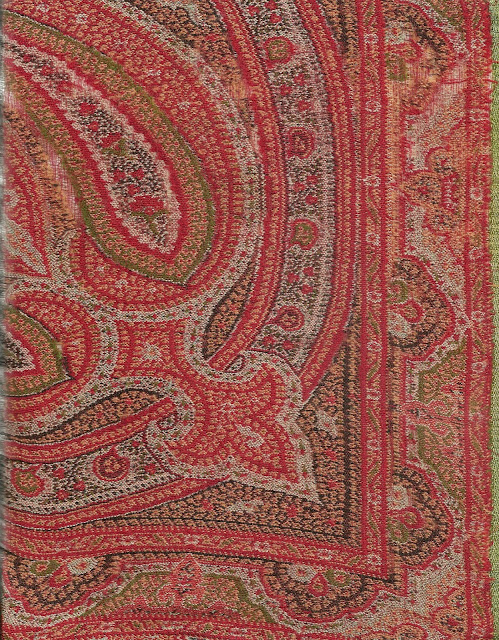Paisley- The Teardrop of India Part 2
The Paisley Shawl
In my blog of 6/28/15 I discussed the Paisley motif. The most common association with this Indian
motif is the Paisley Shawl, a much sought-after fashion accessory of the 18th
and 19th Centuries. Although the term “shawl” today refers to a
rectangular or square of cloth worn as a wrap around the shoulders or head, the
word is derived from “shal”, Persian for any finely woven cloth.
For centuries the finest woven shawls came from Kasmiri,
north of India in the Himalayas. The
wool fibers, which we refer to as “cashmere” are more correctly called
“pashmina” and come from the underbelly of mountain goats. Indian shawls were always handwoven in 2/2 twill
tapestry weave on a horizontal loom, the technique known as “kanikar ".
Colored wefts were inserted with small bobbins and, as in true tapestry weave,
they did not extend from selvage to selvage but were confined to the actual
pattern. European woven shawls used a
continuous supplementary weft which floated over the reverse. Produced as early
as the 15th C Kasmiri shawls were introduced into the European
market near the end of the 1700’s, however, they were extremely scarce and
extremely expensive.
Because of their popularity despite the cost, European
textile manufacturers began to produce what were called “imitation
Indians”. As it was not possible to
import the fine pashmina wool ( their experiments with raising the actual
mountain goats in Europe, a failure) they firstly wove the shawls in silk
at Spitalfields using copies of the
original Indian patterns. Other cities
such as Edinburugh and Norwich soon followed.
But it was Paisley, Scotland
that lent its name to this textile.
Because Paisley was a center for dyeing, printing and fringing, as well
as weaving it soon became the major producer of the imitation Indian shawl.
However, it was the French textile industry that had the
most impact on the shawl production as well as other fabrics of intricate woven
designs. In 1801, Joseph-Marie Jacquard
developed a weaving loom, replacing the draw-loom. In short order the British began weaving copies of the French
imitations.
Another Kasmiri technique, amlikar, used embroidered motifs
after weaving the plain ground fabric.
Because several artisans could embroider simultainously, the time to
produce the textile was significantly shortened and the resultant cost to
produce was much less. These
embroidered shawls were so finely made that they are often confused with the
woven ones
Woven shawls were replaced with printed ones. By the 19th C shawls were block
printed on cotton or silk precisely imitating the original designs. By the end of the 19th C roller
printing replaced block printing and lengths of paisley motif fabrics were
produced.
The actual paisley design and shape of the shawls, as well
as the palette, varied with the lady’s fashion of the day. Identification and dating of these textiles depends upon the following
criteria:
1. distribution of the design
2. density of the pattern
3. repeat of the pattern
4. symmetry
5. contrast between the ground and
design
6. shape and finished size of the
textile
Section of a woven wool shawl. Note the black background which formed a very large square in the center of the textile.
Reverse
Main Boteh motif. Colors include red, black, blue, green and ochre
Green selvage edge
Fringe edge of shawl. The fine black fringe is entirely missing in this section.
Woven paisley shawls may still be found, however, if they are in good condition they are pricey. You may find these textiles in varying conditions and, depending upon the intended use, they may be repaired for table covers or sections may be salvaged for use as applique elements. Printed paisley is more affordable.






Your blog so inspiring
ReplyDeleteThese posts are great